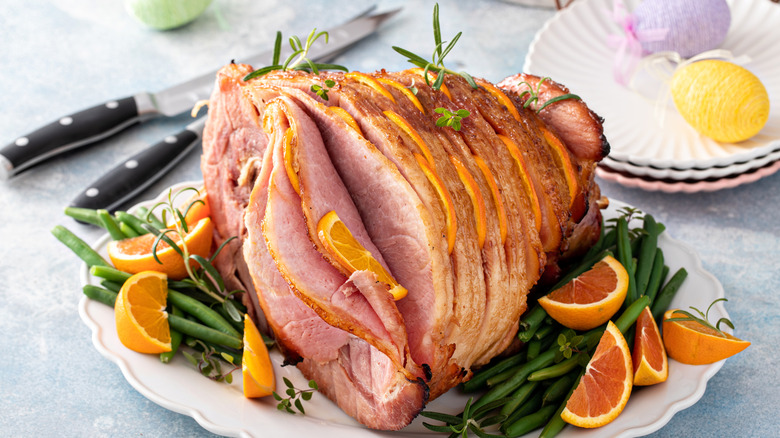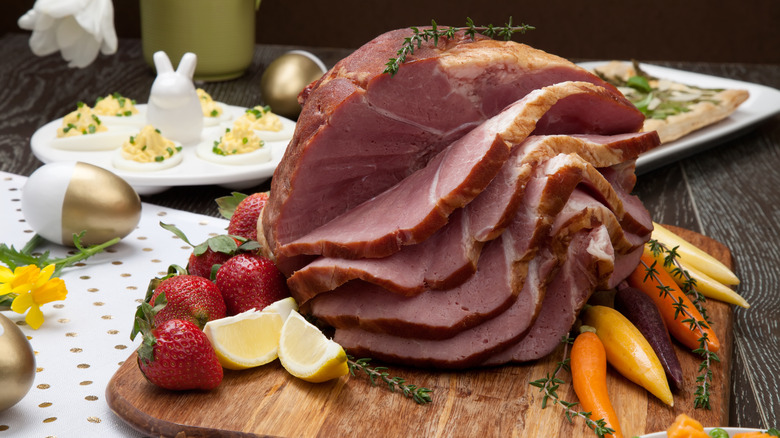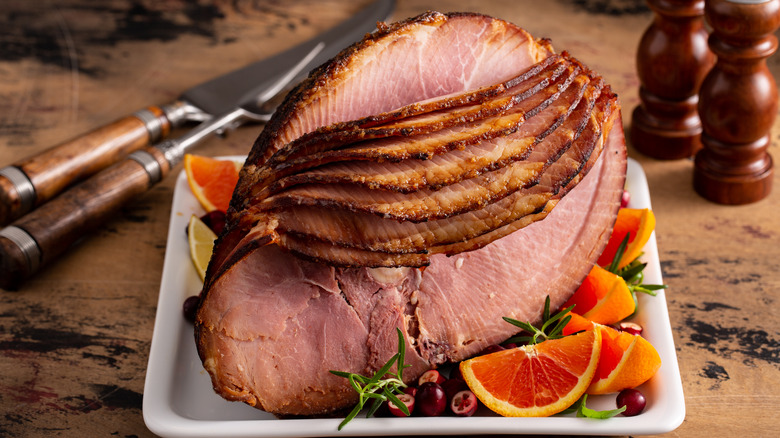The Exact Time You Need To Start Thawing Ham For Easter
Since time immemorial, a block of succulent ham has been the centerpiece of a proper Easter dinner. If you're like many people, who plan ahead by purchasing your ham a week in advance and stashing it in the freezer until the big day, it's crucial to know the ins and outs of thawing it properly. Incorrect thawing isn't just a headache food safety-wise, but you'll also waste a lot of the ham's rich flavor.
As a rule of thumb, you'll need to allow four to six hours of thawing for every pound of ham. So, a 10-pound ham would need to be moved to the fridge around two days before you plan to cook it, to ensure it thaws perfectly.
Speaking of the fridge: Yes, you should thaw your ham in the fridge and not on the countertop. By maintaining a consistent temperature below 40 degrees Fahrenheit, it ensures that the ham stays in the safe temperature zone, which will prevent bacteria from growing inside of your ham and jeopardizing your dinner. Plus, the fridge's coolness will also allow the ham to thaw more gradually, leading to a juicier and tenderer product in the end.
Forgot to thaw it? Give it a cold water bath
If you've just realized you forgot to start thawing your ham before Easter, don't worry! There's a last-minute solution that can help save your dinner plans. Give your ham a cold water bath to speed up the thawing process. Here's how: Fill a large container with cool tap water, then seal your ham in a waterproof zip-top bag and submerge it completely in the water. Full submersion is crucial here. The ham has to be fully underwater to ensure even thawing. Refresh the water every 30 minutes to keep it cool and prevent it from getting lukewarm.
The thawing time varies with the size of your ham, generally taking about 30 minutes per pound. Although this method is still safe, it's more labor-intensive, and might not be ideal if you're also juggling the preparation of other delicious recipes to celebrate Easter. Plus, you'll have to cook the ham immediately once it's been defrosted, or it will become unsafe to eat.
Frozen ham can still be cooked
If you're really short on time, as in: "It's currently 9:00 in the morning, and guests will arrive at 5:00, and the ham has to go into the oven stat," you still have the option to cook the ham frozen. Yes, cooking a frozen ham is totally fine, just with a couple of caveats.
Think of your oven as an emergency defrosting device. The ham is going to need extra time to both thaw and cook properly. You'll need to extend the cooking time by roughly 50% more than what your recipe suggests for a thawed ham. So, if your traditional Easter ham recipe calls for four hours of cooking time, prepare to have the oven running for about six hours for a fully-frozen ham. This method isn't quick, but it's the fastest option under the circumstances.
Keep in mind, this is a general guideline. To avoid the risk of food-borne illness, which is a serious concern when cooking frozen meat, make sure to use a meat thermometer. After the oven signals that the cooking time is up, check the ham's internal temperature. It should reach 145 degrees Fahrenheit to be safe for eating, per the USDA. If it's not there yet, continue cooking the ham in 15-minute increments until it reaches the right temperature. But if all else fails and you're completely out of time, there's always the option to roast a pre-cooked Easter ham instead.


